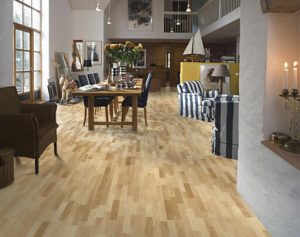Engineered maple floor offers the look of solid maple with enhanced stability. It’s constructed with a top layer of real maple wood bonded to a plywood or high-density fiberboard core, making it suitable for more varied installation environments. This flooring is a smart solution for homeowners seeking durability, visual appeal, and flexibility.

Construction and Structure
The defining feature of engineered maple flooring lies in its multi-layer design. Unlike solid wood, which is one material throughout, engineered wood consists of several cross-layered base layers topped with a veneer of hardwood maple.
Top Layer: Real Maple Veneer
This layer determines the visual appeal. Depending on the thickness, it may allow for one or two rounds of sanding and refinishing, preserving the floor’s beauty over time.
Core Layers: Dimensional Stability
The core is made of plywood or composite wood arranged in crisscross patterns, which greatly reduces the risk of expansion and contraction due to changes in temperature or humidity. This makes engineered maple ideal for basements, apartments, and homes with radiant heating systems.
Installation Flexibility
Engineered maple floor adapts well to different subfloor types and installation techniques, making it a versatile choice for remodels or new builds.
Floating Floor Option
Many engineered maple products can be installed as floating floors, using a click-lock mechanism that requires no nails or glue. This option is fast, clean, and suitable for DIYers.
Glue-Down and Nail-Down Options
In high-traffic areas or commercial installations, glue-down or nail-down methods may be preferred. These methods provide additional stability and reduce movement underfoot.
Design and Style Options
Engineered maple floors come in a variety of finishes, textures, and plank widths, providing flexibility for a wide range of interior aesthetics.
Finishes and Surface Treatments
Options range from natural matte to high-gloss finishes, with some floors featuring hand-scraped or wire-brushed textures to add depth and character. Prefinished versions save installation time and reduce exposure to fumes.
Plank Size and Color Variations
Engineered maple is available in both narrow and wide planks. Lighter tones enhance space and brightness, while stained versions offer richer hues like walnut or espresso. The natural grain remains visible, preserving maple’s signature look.
Durability and Maintenance
While engineered maple is slightly less durable than solid hardwood in terms of refinishing potential, it performs well in everyday use and is easier to maintain in moisture-sensitive areas.
Wear Layer Thickness
Engineered floors come with different wear layer thicknesses—usually ranging from 1mm to 6mm. Thicker wear layers extend the life of the flooring and allow for occasional refinishing if needed.
Cleaning and Upkeep
Regular vacuuming and occasional damp mopping are usually sufficient. Avoid excessive water and use pH-neutral hardwood cleaners. Rugs and floor protectors help prevent scratches and wear in high-use zones.
Environmental and Cost Considerations
Engineered maple is often considered a more sustainable alternative to solid hardwood due to its efficient use of raw materials and energy.
Eco-Friendly Aspects
Using less hardwood and more recycled or fast-growing core layers reduces environmental impact. Many products are certified by organizations like FSC or FloorScore, verifying responsible sourcing and indoor air quality safety.
Cost Efficiency
Engineered maple is generally more affordable than solid maple flooring, both in terms of material cost and installation labor. It offers a cost-effective way to enjoy the beauty of hardwood in a wider range of rooms.




